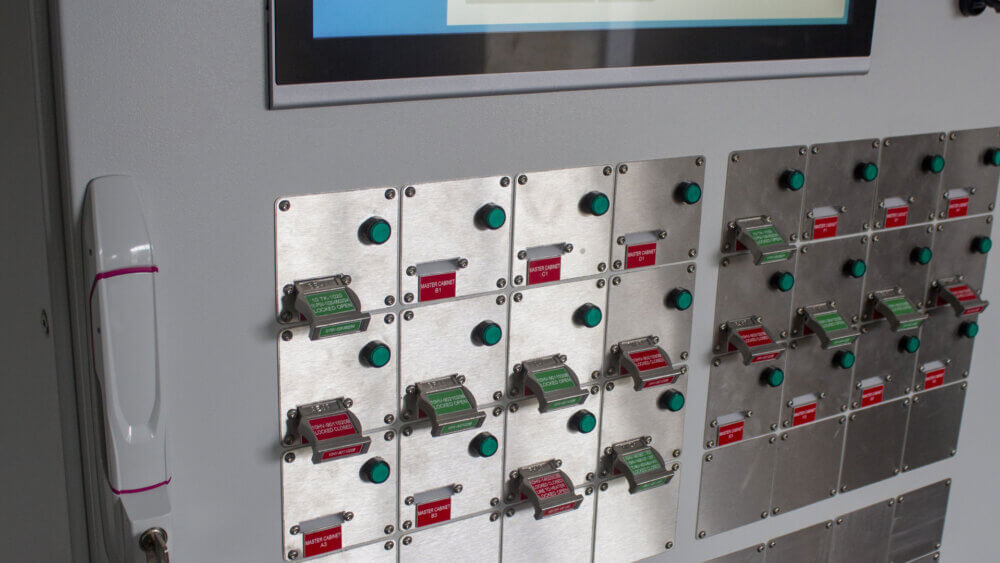Mechanical valve interlocks guarantee strict adherence to procedure and thus avoid human error. They are particularly useful for operations that are generally recognized as highly dangerous, such as pigging. Valve interlocks are a cost-effective measure that results in extremely high safety levels. New developments create intelligence that allows each step within a pipeline pigging operating sequence to be monitored, controlled and authorized. Traditionally however, valve interlocks function as independent and stand-alone safety systems. But as advanced digital technology now enables us to combine process control and safety instrumented functions within a common automation infrastructure, wouldn’t it be better to integrate operator procedures, such as those safeguarded by mechanical interlocks, with the Distributed Control System (DCS) and Safety Instrumented System (SIS) as well?
Separate systems for process control and safety
Historically, separate systems and different technologies provided protection against common-cause failures, in which one problem makes multiple devices or systems fail. Mechanical interlocks perfectly fit within the common philosophy that process control systems and safety systems should always be separated. Once a predefined order of operations has been established and safeguarded by interlocks, there is no other option available than to strictly follow that same predefined sequence of actions. As this sequence can never be altered or overridden, neither manually nor from the DCS, it ensures adherence to the safety procedure.
Combining process control and safety instrumented functions
Within process safety in the traditional sense, add-on components protect personnel from injury and from economic or environmental loss. However, modern safety solutions go far beyond this notion. The deployment of intelligent, integrated safety solutions can save costs, while simultaneously improving process and personnel safety. Maintaining separate engineering, operation, and maintenance infrastructures for control and safety systems also involves additional costs, and many companies are now considering the merits of a more integrated architecture. More and more, process control and safety instrumented functions are combined within a common automation infrastructure for plant control and plant safety.
Hold process variables to predetermined levels
Different approaches exist when it comes to interfacing a plant’s DCS, Programmable Logic Controller (PLC), or relay system with the SIS. The primary function of a DCS or PLC however is always the same; to hold specific process variables to predetermined levels in a dynamic environment. A SIS on the other hand is a static system that takes action when a process is out of control and the control system is unable to operate within safe limits.
‘Traditional style’ plant control
Traditionally, the DCS and SIS were interfaced through a gateway, with each system having its own operator interfaces, engineering workstations, configuration tools, data and event historians, asset management, and network communications. In addition to segregation of control and safety equipment, there is separation of responsibilities. The safety engineer is focused on safe operation, whereas the process engineer wants to maximize plant availability and operational profit.
‘New style’ plant control
Because of the costs associated with the separate system approach, many companies started looking for integrated solutions. These solutions have different controllers for DCS and SIS, but they have one engineering, operation and maintenance tool (1). Advanced digital technology has made it possible to combine process control and safety instrumented functions within a common automation infrastructure, all while ensuring regulatory compliance. Industrial facilities can realize significant advantages from seamless – but still secure – integration of plant control and safety systems. Some of the potential benefits include accurate time synchronization, elimination of data mapping duplication, the creation of a common HMI (Human Machine Interface) and reduced operator and maintenance training requirements (2).
How do mechanical valve interlocks fit in modern infrastructures for plant control and safety?
Process industries around the world face lots of operational challenges. Ensuring the safety of personnel, equipment, and the environment are priorities for every facility. At the same time, plants must find ways to increase process efficiency and to improve their overall business performance. In order to achieve these goals, common automation infrastructures enable them to ensure safety and at the same time increase process efficiency and thus save costs. Mechanical interlocks should be connected to the DCS and SIS to create common automation infrastructures. However, as many systems for process control and process safety are electronically powered, how can they communicate with manually operated mechanical interlocking systems?
‘Smart’ valve interlock products improve overall safety level
New electro-mechanic applications combine electrical and mechanical processes, procedures and feedback. With regard to mechanical valve interlocks, this has resulted in a new breed of products that focus on the use of electro-mechanical and PLC-controlled cabinets. These cabinets allow for communicating detailed instructions, monitoring the status of complex procedures and operating part of a sequence from the control room. Moreover, variables such as vessel pressure and H2S levels can be incorporated within safeguarded operating procedures. In all, electro-mechanics enable mechanical valve interlocks to be fully integrated within the context of a common system for control and safety. Amongst others, ‘intelligent’ or ‘smart’ valve interlock products are based on the idea that ultimately all processes within a facility should somehow be interconnected with each other in order to create substantial levels of overall process safety. If companies only focus on highly dangerous processes to be safeguarded and disregard the other less dangerous processes, they will never be able to guarantee SIL 3 and 4 safety levels.
Conclusion
‘Intelligent’ or ‘smart’ valve interlock products combine the reliable characteristics of mechanical valve interlocks with dynamic possibilities of electromechanical solutions. By integrating operator procedures with DCS and SIS it allows integration of mechanical safety products with electronic communication, authorization and proofing possibilities. Integrating mechanical interlock systems within common infrastructures for plant control and plant safety also perfectly fits within the notion that ultimately all processes within a facility should somehow be interconnected with each other. This way, substantial levels of process safety can be created, while at the same time realizing efficiency and cost savings.
1) ‘Integrated Control + Safety’, Siemens, on www.industry.siemens.com
2) ‘Integrated DCS and SIS’ by J. School en E. de Groot, as published on ‘InTech’, www.isa.org, the online magazine of ISA (International Society of Auto
This article is part of a publication produced and presented by Sofis on the PPSA seminar on ‘OPERATIONAL PIPELINE PIGGING for operators, contractors and engineers’.


